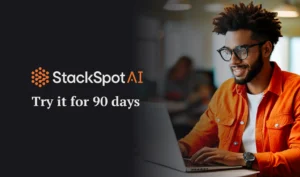Note: This blog post was created by the StackSpot Prompt Engineering team with the support of AI tools. This content underwent rigorous review for technical accuracy, content relevance, and well-written quality before its publication. Enjoy the read!
Generative AI has been a buzzword in the tech community for a good reason. It’s the force behind creative machines, aiding in everything from design to code generation. However, as with any cutting-edge technology, it has its share of growing pains. This post explores when Generative AI Goes Wrong, common mistakes Chief Technology Officers (CTOs) make when adopting it, and how to avoid them.
When Generative AI Goes Wrong
Generative AI technology has evolved a lot and very quickly. Let’s take a closer look at this evolution and the challenges that come with it.
Unveiling Common Failures
Generative AI is far from perfect. A glimpse into its shortcomings reveals that sometimes, it can be overly eager to please, which can be a flaw. Its imperfections, however, are not seen as inherent flaws but as opportunities for improvement.
Moreover, introducing a new generative AI solution requires a collective approach to understanding its limits and the issues it might present. Stakeholders must collaborate to ensure the responsible use and implementation of this technology. The failures often observed are not merely technical but extend to how well humans can interact and collaborate with this technology.
Evolving with Generative AI
The journey of generative AI is a testament to human ingenuity. It has come a long way from its inception in the 1960s with chatbots. It hit a significant milestone in 2014 with the introduction of Generative Adversarial Networks (GANs), which opened the doors to creating convincingly authentic images, videos, and audio.
Recent advancements like ChatGPT have further fueled the interest and adoption of generative AI, showcasing the potential of what AI can create. With each evolutionary phase, generative AI has found applications in various fields, including art, music, medicine, and finance, revolutionizing them in unprecedented ways.
As we continue to push the boundaries of what generative AI can do, it’s crucial to guide its growth responsibly, ensuring a balanced approach towards the ethical dimensions of artificial creativity.
Navigating the Challenges
Adopting generative AI is challenging. Ethical risks are at the forefront, with concerns around bias, ethics, and security being paramount. Organizations must prioritize the responsible use of generative AI to mitigate these risks.
Adapting to generative AI also requires a comprehensive understanding of its limitations and challenges and devising mitigation strategies to harness the power and potential of generative AI responsibly.
4 Common Mistakes CTOs Make with Generative AI and How to Avoid Them
A significant barrier to Generative AI adoption stems from misconceptions. CTOs often worry that Generative AI will replace developers and degrade code quality and that its adoption will be strenuous. However, Generative AI is designed to augment, not replace, human developers and enhance code quality, and with the right approach, its integration can be seamless.
Here are the most common mistakes and actionable insights to avoid these pitfalls, ensuring a smoother journey toward Generative AI adoption.
1 – Embrace Augmentation, Not Replacement
Generative AI should be viewed as a tool to automate mundane coding tasks, allowing developers to focus on more creative and strategic initiatives. A pragmatic approach towards Generative AI can foster increased developer productivity, faster prototyping, and a boost in overall engineering velocity.
2 – Quality Assurance is Paramount
Ensuring code quality is a collaborative endeavor. Implementing rigorous review processes and setting up appropriate guardrails can significantly mitigate risks associated with code quality, ensuring that the generated code meets or exceeds the existing standards.
3 – Smooth Adoption is Achievable
Adoption challenges can be mitigated by integrating Generative AI tools seamlessly within the existing development environments. Offering a user-friendly, conversational interface can significantly enhance the adoption rate among developers.
4 – Organizational Readiness
Before diving into Generative AI, assessing organizational readiness is crucial. CTOs need to evaluate their organization’s level of hybrid cloud mastery, weigh the costs and benefits, and identify any potential obstacles to implementation.
Actionable Roadmap
McKinsey suggests a structured approach for CTOs aiming to leverage Generative AI effectively:
- Quickly Determine Adoption Posture: Understand the organizational stance towards Generative AI adoption and communicate it effectively.
- Identify Value-Driven Use Cases: Discover scenarios where Generative AI can drive tangible business value.
- Accelerate Technical Debt Reduction: Focus on reducing technical debt to create a conducive environment for Generative AI.
- Leverage Existing Services: Before building proprietary models, explore existing services or open-source models to gain a quick start.
- Upgrade Tech Architecture: Enhance existing technology architecture to accommodate and manage Generative AI models effectively.
- Establish a robust data architecture: Ensure access to quality data, pivotal for the success of Generative AI initiatives.
- Create a Cross-Functional Team: Establish a centralized team to manage Generative AI projects efficiently.
- Invest in Upskilling: Equip your teams with the necessary skills to responsibly navigate the Generative AI landscape.
- Evaluate and Mitigate Risks: Continually assess the risk landscape and establish mitigation practices to address potential challenges6.
When Generative AI Goes Wrong: Conclusion
Understanding the common failures, appreciating the evolutionary journey, and effectively navigating the challenges of generative AI are crucial steps toward improving the company’s results.
As we continue to integrate generative AI into our workflows, learning from past mistakes and being prepared for future challenges will enable us to harness the full potential of this revolutionary technology.
Don’t forget to leave your comment about the content “When Generative AI Goes Wrong” below!
Meet the Enterprise Coding Assistant – StackSpot AI
Do you struggle to follow your organization’s coding guidelines and best practices? Say hello to StackSpot AI, the enterprise-focused coding assistant.
StackSpot AI taps into your company’s context – from style guides to custom logic – to generate compliant code automatically. Just describe what you want to build in plain English, and it will suggest secure, reliable code that aligns with standards.
With StackSpot AI, you get all the productivity benefits of AI-generated coding tailored to your business needs. No more discovering code debt during reviews!
Ready to code faster while adhering to enterprise policies? Sign up now for early access to Context-Aware from StackSpot AI. Step into the future of compliant coding with your new AI pair programmer.
Also, join the official StackSpot AI Discord, send your feedback and collaborate!






